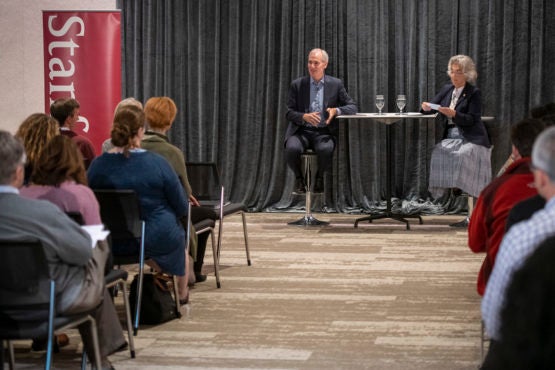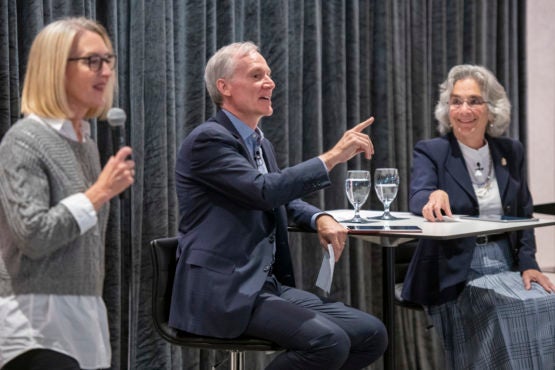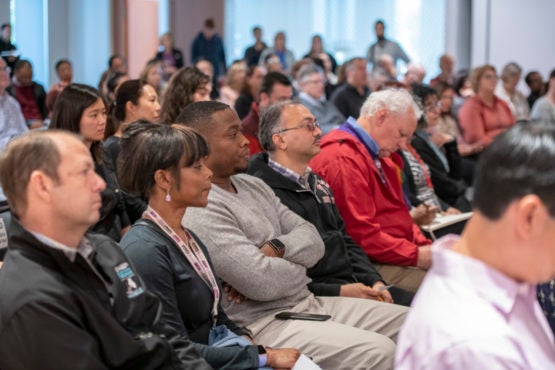President and provost host community conversation at new Redwood City campus
President Marc Tessier-Lavigne and Provost Persis Drell answered questions about the long-range vision and other issues during a community meeting on Tuesday.
President Marc Tessier-Lavigne and Provost Persis Drell on Tuesday hosted their first community conversation at Stanford Redwood City, updating the university community on the long-range vision and addressing a variety of issues, from affordability and the 2019-20 budget priorities to the status of the university’s application for an updated general use permit.

President Marc Tessier-Lavigne and Provost Persis Drell hosted the first community conversation at Stanford Redwood City. (Image credit: L.A. Cicero)
The hour-long meeting in Cardinal Hall on the new Stanford Redwood City campus drew approximately 125 Stanford community members with many more watching via live webcast from the Palo Alto campus and other locations.
Tessier-Lavigne began the meeting with an acknowledgment of the staff members who have recently moved, as well as those who soon will be moving, to the new Redwood City campus.
“We are deeply grateful for how you have embraced this major change for our university and also for the ways you have brought Stanford to life here in Redwood City,” he said. “Your collaboration, your optimism and your flexibility are already shaping this new campus.”
Tessier-Lavigne also thanked the leaders and staff of Land, Buildings & Real Estate, University Human Resources, University IT, Residential & Dining Enterprises and other groups for their work in assuring a smooth transition to the Redwood City campus.
The move to Stanford Redwood City is at the midway mark, with approximately 1,100 employees currently occupying the campus and another 1,200 expected to move in by mid-July. A schedule outlining which units have relocated or will be relocating and their respective move dates can be found on the Cardinal at Work website.
Long-range vision
In an update on the long-range vision, Tessier-Lavigne said that the design teams and Executive Cabinet have been developing “actionable plans” that are rolling out in stages. He noted that some efforts, such as the Stanford Center for Human-Centered Artificial Intelligence, ResX and IDEAL (Inclusion, Diversity, Equity and Access in a Learning Environment), launched this spring while others will get under way in the coming months.
He said that university leaders identified broad themes across the design teams to create three strategic initiatives: Advancing and Bridging Disciplines, Building Pathways to Impact, and Strengthening Communities on Campus and Beyond. Specific programmatic activities stemming from the work of the design teams will be nested under each initiative. For instance, IDEAL will be one of the activities in Strengthening Communities.
Tessier-Lavigne encouraged the community to tune in to the livestream of the upcoming annual Academic Council meeting on May 23, where he and other university leaders will share more details of the strategic initiatives and the next steps for implementation.
General Use Permit
Tessier-Lavigne also spoke about the current status of Stanford’s application for a new General Use Permit and how it relates to plans for the future of the university.
The General Use Permit is a long-term land use permit that sets parameters for measured development within the existing main campus over the next couple decades. It also addresses broader regional concerns, including housing affordability and availability, sustainability and traffic congestion.

Elizabeth Zacharias, vice president for human resources, joined Marc Tessier-Lavigne and Persis Drell to answer questions from members of the audience. (Image credit: L.A. Cicero)
“As we think about the exciting and important ways in which Stanford can enhance its contributions to our region and the world, it’s clear that our ability to evolve and adapt our facilities in the coming years is going to be essential to meeting those goals,” he said.
Stanford’s application requests the ability to add academic square footage – about 1.2% per year – to respond to the changing needs of the university’s academic program. The application also requests the ability to add several thousand new housing units and student beds over that period of time to help address the regional housing shortage and support the needs of the Stanford community.
Tessier-Lavigne countered recent news coverage suggesting that the process isn’t moving forward or that Stanford is withdrawing from part of the process.
“I want to take this opportunity to clarify that we are still very much moving ahead. We have had concerns about some parts of the county’s review process, and those concerns led us to ask the county to slow things down,” he said.
One issue in particular, he said, is that the university has been unable to start “meaningful discussions” with the county about a development agreement – in essence, a contract that specifies benefits that Stanford would provide to the broader community over the lifetime of the General Use Permit, in exchange for the certainty that the university would be able to complete its long-term development.
Tessier-Lavigne said that the review process is continuing and is currently with the County Planning Commission. More information can be found in a new question-and-answer feature on Stanford’s General Use Permit website.
Affordability a key issue
Reporting on the 2019-20 budget, Drell said, “It is a tight budget year, and at the same time Stanford has great aspirations as a community and we have significant needs – both for what we do here on our campuses but also for what we contribute to the world.”
In making strategic choices about what to fund, she said the budget group developed two guiding principles: to provide for the current pressing needs of the campus community and to make strategic investments for the future that align with the priorities in the long-range vision.
Noting that much of the budget is restricted to specific uses, Drell said that general funds, which are the most flexible, would be used for some high-priority areas, including student mental health services, faculty diversity incentives and shared research resources and platforms.
Several funding priorities in the budget directly address the issue of affordability for the campus community. These include a solid staff and faculty compensation program, increases to undergraduate financial aid, additional support of programs for graduate students and postdoctoral scholars, and the construction of new housing. Drell said that more than half of the capital budget is devoted to housing.
“Affordability is one of the biggest challenges we face as an institution. It’s a huge issue for us and it’s a huge issue for the entire Bay Area,” Drell said.
She then reported on the activities of the Affordability Task Force, which is charged with proposing solutions to address the financial challenges facing members of the campus community, particularly in the areas of housing, transportation, benefits and child care. She directed the community to a recent Stanford Report story on the task force.
Drell said there is “no one-size-fits-all solution” to the affordability challenges facing the Stanford community, and the task force has organized its work around five stakeholder groups: faculty, academic staff, staff, postdoctoral scholars and graduate students. Since fall 2018, the task force has done significant outreach, including focus groups, town hall meetings and affordability assessments. University-wide, 14,000 people participated in the assessments, which shows a high degree of interest in this issue, Drell said.
This summer, task force members will develop preliminary recommendations based on what they’ve heard through their own research along with the data from the affordability assessments.
“We’re not at the point of final recommendations, but a lot of very thoughtful and very important work is going on,” she said.
Some early actions the university has taken on this issue include raising the minimum salary for postdoctoral scholars and providing need-based emergency support for graduate parents.
Questions from the community
Following their opening remarks, Tessier-Lavigne and Drell fielded questions submitted by both live and online audiences.
Several questioners asked how the university is encouraging engagement across the campuses.
Tessier-Lavigne said that connectivity between the campuses was critical and that one way is for the community to become more accustomed to using technology such as livestreaming, videoconferencing and teleconferencing. He also said that Stanford leadership will be a regular physical presence on both campuses through events such as town halls and other types of meetings.
He noted that the university is also looking at ways to connect the campuses through a variety of programming opportunities, some of which will be coordinated through the new Office of Community Engagement led by Matthew Tiews. He said that there was no specific programming plan yet, but it might include livestreaming more events and some academic programming such as lectures.
“We are very mindful of the fact that as we have opened Redwood City and as we look at flexible work opportunities, we want to make sure that every Stanford employee feels they are a full member of the community,” Tessier-Lavigne said.
Transportation between the campuses was another concern for some community members. While there is no plan to offer regular shuttle service between the campuses, Tessier-Lavigne said that for specific events it might be appropriate to offer shuttles. He said that in some cases it might be better to mirror the event on the Redwood City campus.
In response to a question about the performance of the university’s endowment, Drell said that while the endowment has done well relative to peer institutions, the growth in the payout has not kept up with inflation, which has made the budget process challenging.
Other topics the president and the provost discussed during the question-and-answer session included increasing faculty and staff diversity, the Stanford Health Care Alliance plan and opportunities to engage with the local Redwood City community.

